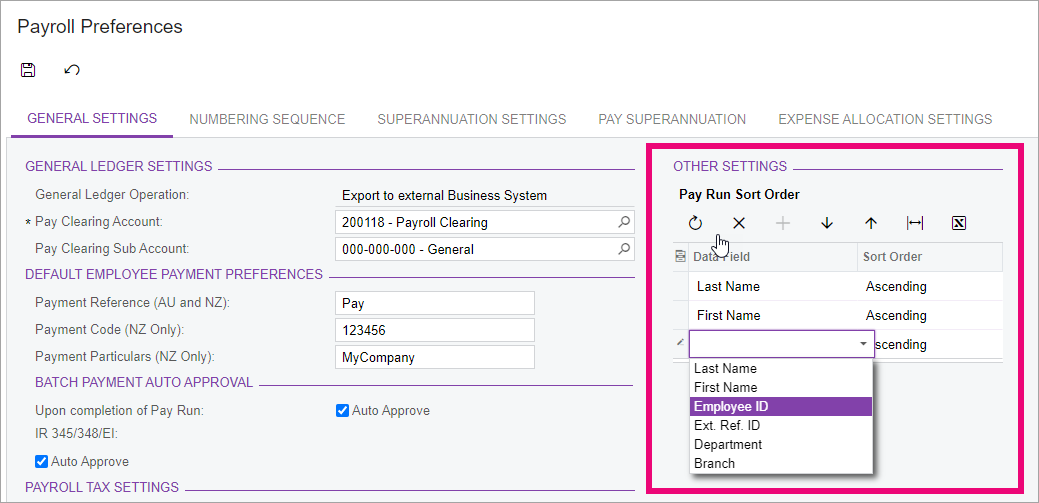2022.1.3 Release notes
New features
MYOB Advanced Business
On the Security Preferences form (SM201060), you can now integrate MYOB Advanced with Microsoft Azure Active Directory (Azure AD) by clicking Configure Azure AD.
Companies that use bank feeds also need a customisation to be able to integrate with Azure AD. This customisation is available on the MYOB Partner self-service portal.

By integrating MYOB Advanced with Azure AD, you can provide single sign-on (SSO) and manage users and access in one place.
For detailed steps on setting up Azure AD, see our online help pages.
MYOB Advanced Payroll
You can now cancel partially paid leave requests, letting you more flexibly manage leave that spans multiple pay periods. You no longer need to do a clunky workaround if an employee has already started their leave. Cancelling leave requests is available both for employees and administrators who can submit leave on behalf of employees.

Plus, a new Days Taken tab is available on the Submit a Leave Request window. This tab breaks down each individual day included in a leave request.
On the Leave Administration form (MPPP5040), new Units Paid and Units Cancelled fields have been added to give administrators a clearer summary of a leave request.

After a leave request has been cancelled, that date becomes available for new requests.
For example
Say an employee has taken a week of annual leave. Two days in, they start feeling unwell. They can cancel the rest of their annual leave and submit a sick leave request instead.
To cancel a leave request
Open the Submit a Leave Request window.
In the Ref. Nbr field, select a leave request.
Make sure leave request's Status is set to Partially Paid.On the Days Taken tab, select the days you want to cancel.
On the table toolbar, click Cancel Leave Request.
On the window toolbar, click the Save icon (

).
You can now choose a default order for how employees are listed in the Pay Run Details form (MPPP3120). This default order will also be used when you move between records on the Employee's Current Pay form (MPPP3130).
To choose the default order, use the Pay Run Sort Order table on the General Settings tab of the Payroll Preferences form (MPPP1100).

On the Employee's Current Pay form (MPPP3130), the main table can now include up to 20 rows, making it easier to see what's included in the employee's pay.
Resolved issues
For one of the following resolved issues, there are extra steps you need to take to fix your historical data.
Region | Description | Reference |
|---|---|---|
NZ | ACTION REQUIRED Previously, MYOB Advanced Payroll ignored liabilities for deduction pay items when calculating annual leave year-to-date (AL YTD) values in termination payments. This has been resolved. You'll now see correct leave rates in all current and future pays, even when a current pay includes backdated leave. If a deduction pay item has been set as:
Although this issue is resolved for current and future pays, historical AL YTD haven't been corrected. These historical values will still be considered until the next annual leave anniversary date. This will be resolved in a future release. For now, a payroll administrator might need to fix these historical values by using current open pays. What you need to doWhen upgrading to version 2022.1.3, if any current pays are open, you need to reset the pay run/termination wizard. | N/A |
AU / NZ | In Employee Self Service, an employee's access in the MYOB Advanced mobile app didn't match their access in MYOB Advanced for web browsers. This has been resolved. | CE00019663 |
NZ | On the Entitlement Movements report, the Value column could include misleading amounts. This happened because, on the Employee's Current Pay form (MPPP3130), the Calculated Units displayed the last two decimals as zeroes. This has been resolved. Now, the Calculated Units shows the full value for leave accrual pay items to six decimal places. | CE00024166 CE00023936 |
NZ | When importing an employee's pay history, some amounts were incorrect. | CE00029304 CE00029141 |
AU / NZ | If subaccounts by branch access were setup, an error could occur when transferring an employee: "Subaccount 'EXAMPLE' cannot be found in the system. Please verify whether you have proper access rights to this object." This has been resolved. | CE00033494 CE00033471 |
AU / NZ | On the Leave Administration form (MPPP5040), deleting a pay item could cause an error: "An unhandled exception has occurred in the function 'GetCurrentBalance'. Please see the trace log for more details." This has been resolved. | CE00033323 CE00033322 |
AU / NZ | The MP-PayActivityDetail general inquiry was incorrectly including cancelled pays. This has been resolved. Now, the general inquiry only includes completed pays. | CE00032828 CE00032804 |
AU | Some fields weren't being audited properly. This has been resolved. The affected fields were:
| N/A |
